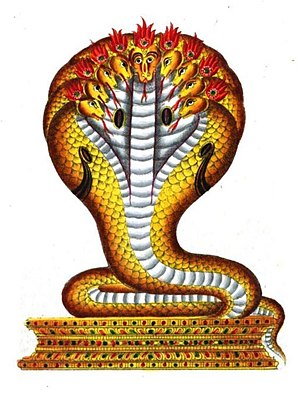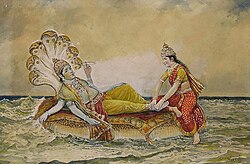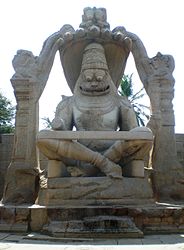Shesha
Topic: Unsolved
 From HandWiki - Reading time: 6 min
From HandWiki - Reading time: 6 min
| Shesha | |
|---|---|
King of Nagas[1] | |
 Ananta Shesha | |
| Other names | Sheshanaga |
| Affiliation | Devotee of Vishnu, Naga |
| Abode | Kshir Sagar |
| Personal information | |
| Parents |
|
| Siblings | Many including Manasa, Vasuki and Takshaka |
| Spouse | Shirsha[2] |
| Children | Sulochana |
Shesha (Sanskrit: Sesa), also known as Sheshanaga (Sesanaga) or Adishesha (Adi Sesa), is the Nagaraja or King of all Nagas and one of the primal beings of creation. In the Puranas, Shesha is said to hold all the planets of the universe on his hoods and to constantly sing the glories of the God Vishnu from all his mouths. He is sometimes referred to as Ananta Shesha, which translates as Endless-Shesha or Adishesha "First Shesha". It is said that when Adishesa uncoils, time moves forward and creation takes place; when he coils back, the universe ceases to exist.
Vishnu is often depicted as resting on Shesha. Shesha is considered a devotee or bhakt of Vishnu. He is said to have descended to Earth in the human forms or incarnations: Lakshman, brother of Vishnu's incarnation Ram during Treta Yuga, and as Balaram, brother of Vishnu's incarnation Krishna during Dwapar Yug. According to the Mahabharat (Adi Parva), his Father was Kashyapa and his Mother Kadru.
"Shesha" in Sanskrit texts, especially those relating to mathematical calculation, implies the "Remainder"—that which remains when all else ceases to exist.
Form
Shesha is generally depicted with a massive form that floats coiled in space, or on the ocean of bliss, to form the bed on which Vishnu lies. Sometimes he is shown as five-headed or seven-headed or ten-headed serpent; but more commonly as one thousand-headed, or five thousand-headed, or ten thousand-headed, or fifty thousand-headed, or one hundred thousand-headed, or even five hundred thousand-headed, or even as many as one million-headed serpent; sometimes with each head wearing an ornate crown.
His name means "that which remains", from the Sanskrit root śiṣ, because when the world is destroyed at the end of the kalpa, Shesha remains as he is.
In the Bhagavadgita of Chapter 10, verse 29, Shri Krishna while describing 75 of his common manifestations, declares, "anantaś ca asmi nāgānāṁ": Of the nagas, I am Ananta.
As per the Mahabharata, Shesha was born to sage Kashyap and his wife Kadru. Kadru gave birth to a thousand snakes, of which Shesha was the eldest. After Shesha, Vasuki, Airavata and Takshaka were born, in order. A lot of Shesha's brothers were cruel and were bent upon inflicting harm on others. They were even unkind to Garuda, who was Kashyapa's son through Vinatha, sister of Kadru. (Kadru and Vinatha were daughters of Daksha).
Shesha, disgusted by the cruel acts of his brothers, left his mother and kin, and took to austere penances. He lived on air and meditated in places including Gandhamadhana, Badrikashrama, Gokarna, Pushkara and Himalayas. His penances were so severe that his flesh, skin and muscles dried up and merged with his frame. Brahma, convinced of his Shesha's will, asked Shesha to request a boon. Shesha asked that he be able to keep his mind under control so that he could continue to perform ascetic penances. Brahma gladly accepted the request. Brahma then asked a favour of Shesha: to go beneath the unstable earth and stabilize it. Shesha agreed and went to the netherworld and stabilized her with his hood. He is known to support her even today, thus making Patala his perennial residence.[3]
Maha Vishnu and Sankarshana
Shesha is also depicted as floating in the ocean of the changing world, forming the bed of Mahavishnu. Since he is known as Adishesha (the foremost of snakes) and because he is Anantashesha or simply Ananta (endless, as He is known to remain in existence even after the end of the Kalpa, when the whole universe is destroyed).
In the Bhagavata Purana Shesha is named Sankarshana, the tamasic energy of Lord Narayana himself, and is said to live deep within the inner layers of patala, where there are many serpents with gems on their heads and where Sankarshana is the ruler. He is said to live since before the creation of the universe. When the universe is towards its end, he creates 11 Rudras from Them to destroy the universe for a new one to be created.
Sankarshana is also one of the four vyuha forms of Vishnu the other three being Vāsudeva, Pradyumna and Aniruddha.
Sankarshana expands himself as Garbhodakshayi-Vishnu in the beginning of the universe to create Brahma. In other words, Lord Sankarshana is Lord Narayana himself.
In previous chapters of the Purana it is also said that Lord Sankarshana spoke the Bhagavata to the Four Kumaras, who in their turn passed this message of the Bhagavata. At some point the message was passed to sage Maitreya who in his turn spoke it to Vidura.
Avatars (Incarnations)
Adisesha took 4 incarnations. During the Satya Yuga, he came down in his original form to form a seat for Lord Narasimha, who incarnated to save his child devotee Prahalada from his father Hiranyakashipu.
During the Treta Yuga, Sesha took birth as Lakshmana, as Lord Vishnu's (as Rama) brother. Lakshmana is a very prominent character in the Ramayana, along with Hanuman and Sita.
During Dwapara Yuga, he incarnated as Balarama again as a brother to Lord Vishnu (as Krishna), and during Kali Yuga, he took birth as Patanjali Maharishi and Ramanujachaya. He was not accompanied by the lord during the Kali Yuga. Instead, he incarnated alone to spread Bhakti among people. It was a peaceful incarnation.
It is considered in Sri Vaishnavism, that Lord Balarama is a mixed incarnation of Lord Vishnu and Sesha.
In a story from the Puranas, Sesha's younger brother Vasuki loosens Mount Mandara, to enable it to be used in the churning of the ocean by the devas and asuras.
The city of Thiruvananthapuram in Kerala is named after him and is translated as "The Holy City of Anantha".
Quotations
- "The foremost manifestation of Lord Vishnu is Sankarṣana, who is known as Ananta. He is the origin of all incarnations within this material world. Previous to the appearance of Lord Shri Krishna, this original Sankarsana will appear as Baladeva, just to please the Supreme Lord Shri Krishna in His transcendental pastimes." Bhāgavata Purāṇa 10.1.24
- "Sri Anantadeva has thousands of faces and is fully independent. Always ready to serve the Supreme Personality of Godhead, He waits upon him constantly. Sankarsana is the first expansion of Vasudeva and because he appears by his own will, He is called svarat, fully independent. He is therefore infinite and transcendental to all limits of time and space. He Himself appears as the thousand-headed Shesha." Srila Jiva Gosvami, in his Krishna-Sandarbha
- "Sankarsana of the quadruple form descends with Lord Shri Rama as Lakshmana. When Lord Shri Rama disappears, Shesha again separates himself from the personality of Lakshmana. Shesha then returns to his own abode in the Patala regions and Lakshmana returns to His abode in Vaikuntha." A. C. Bhaktivedanta Swami Prabhupada
- In the Bhagavad-Gita, when in the middle of the battlefield Kurukshetra, Shri Krishna explaining his omnipresence, says: "Of Nāgas, I am Ananta" indicating the importance of Ananta Shesha.
Narasimha, the man-lion incarnation of Vishnu seated on the coils of Shesha, with seven heads of Shesha forming a canopy. statue at Vijayanagara.
In Culture
The Palliyodam, a type of large built and used by Aranmula Parthasarathy Temple in Kerala for the annual water processions of Uthrattathi Jalamela and Valla Sadhya has the legend that it was designed by Lord Krishna and were made to look like Shesha.[4]
Other names
- Sheshanaga (Sesha the serpent)
- Adishesha (the first Sesha)
- Anantashesha (Endless Sesha)
- Ananta (endless/infinite)
- Alternative spellings: Sesa, Sesha, Śeṣa
- Shesha Sayana or Nagar Syana means Vishnu who sleeps (Sayana) on Sheshanaga
See also
- Hedavde Mahalaxmi Mandir Sesh Naag
- Leviathan
- Ouroboros
- Jörmungandr
- Wagyl
- Nāga
- Snake worship
- Nagaradhane
- Vishnu
- Padmanabhaswamy Temple
References
- ↑ Handa 2004, p. 91.
- ↑ Daniélou, Alain (December 1991) (in en). The Myths and Gods of India: The Classic Work on Hindu Polytheism from the Princeton Bollingen Series. Inner Traditions / Bear & Co. pp. 163. ISBN 978-0-89281-354-4. https://books.google.com/books?id=1HMXN9h6WX0C&q=Bhishma.
- ↑ Mbh, Adi Parva
- ↑ "Explained: What is a Palliyodam, and why a Kerala actor was arrested for photoshoot on it". thenewsminute. https://www.thenewsminute.com/article/explained-what-palliyodam-and-why-kerala-actor-was-arrested-photoshoot-it-155155.
Bibliography
- Handa, Om Chanda (2004), Naga Cults and Traditions in the Western Himalaya, Indus Publishing, ISBN 978-8173871610, https://books.google.com/books?id=Xd50t19YpJEC
External links
- ananta supports the world (from mahAbhArata)
- The Glories of Lord Ananta (from Śrimad Bhagavatam)
- Ananta Sesha - The Legendary Serpent
- Maha-Vishnu & Ananta Sesha
- Image of ancient Vishnu and Sesha deity form
 KSF
KSF








